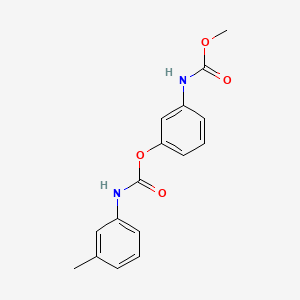D1047 | phenmedipham
| Toxicity | Dose | Time | Species | Model | Method | Action | Positive criterion | Reference |
|---|---|---|---|---|---|---|---|---|
| MEMBRANE POTENTIAL | 4.41±2.02 | human | qHTS-HepG2 | MMP assay | decrease | IC50 | 163 | |
| MEMBRANE POTENTIAL | 7.08 | human | HepG2 | MMP assay | decrease | IC50 | 163 | |
| MEMBRANE POTENTIAL | 19.38±9.11 | rat | hepatocytes | MMP assay | decrease | IC50 | 163 | |
| Pictogram | Signal | Statements | Precautionary Statement Codes |
|---|---|---|---|
 |
Warning |
H400: Very toxic to aquatic life [Warning Hazardous to the aquatic environment, acute hazard] H410: Very toxic to aquatic life with long lasting effects [Warning Hazardous to the aquatic environment, long-term hazard] |
P273, P391, and P501; (The corresponding statement to each P-code can be found at the GHS Classification page.) |
 |
Warning |
Aggregated GHS information provided by 320 companies from 4 notifications to the ECHA C&L Inventory. Each notification may be associated with multiple companies. H400 (99.69%): Very toxic to aquatic life [Warning Hazardous to the aquatic environment, acute hazard] H410 (83.75%): Very toxic to aquatic life with long lasting effects [Warning Hazardous to the aquatic environment, long-term hazard] Information may vary between notifications depending on impurities, additives, and other factors. The percentage value in parenthesis indicates the notified classification ratio from companies that provide hazard codes. Only hazard codes with percentage values above 10% are shown. |
P273, P391, and P501; (The corresponding statement to each P-code can be found at the GHS Classification page.) |
 |
Warning |
H410: Very toxic to aquatic life with long lasting effects [Warning Hazardous to the aquatic environment, long-term hazard] |
P273, P391, and P501; (The corresponding statement to each P-code can be found at the GHS Classification page.) |
 |
Warning |
H373: Causes damage to organs through prolonged or repeated exposure [Warning Specific target organ toxicity, repeated exposure] |
P260, P314, and P501; (The corresponding statement to each P-code can be found at the GHS Classification page.) |
| 13684-63-4 | 3-((METHOXYCARBONYL)AMINO) PHENYL N-(3-METHYLPHENYL) CARBAMATE (PHENMEDIPHAM) | 3-((Methoxycarbonyl)amino)phenyl (3-methylphenyl)carbamate |
| 3-((Methoxycarbonyl)amino)phenyl N-(3-methylphenyl)carbamate (Phenmedipham) | 3-((Methoxycarbonyl)amino)phenyl m-tolylcarbamate | 3-(Carbomethoxyamino)phenyl 3-methylcarbanilate |
| 3-(Methylphenyl)carbamic acid 3-((methoxycarbonyl)amino)phenyl ester | 3-(methoxyformamido)phenyl (3-methylphenyl)carbamate | 3-Methoxycarbonyl-N-(3'-methylphenyl)-carbamat |
| 3-Methoxycarbonyl-N-(3'-methylphenyl)-carbamat [German] | 3-Methoxycarbonylaminophenyl 3'-methylcarbanilate | 3-Methoxycarbonylaminophenyl N-3'-methylphenylcarbamate |
| 3-[(Methoxycarbonyl)amino]phenyl (3-methylphenyl)carbamate | 3-[(Methoxycarbonyl)amino]phenyl N-(3-methylphenyl)carbamate | 3-methoxycarbonyl-N-(3'-methylphenyl)-carbamate |
| 3-methoxycarbonylaminophenyl N-3'methylphenylcarbamate | 4CH-007622 | 684P634 |
| A807149 | AK129706 | AKOS015895890 |
| AX8147450 | Alegro | BDBM50311785 |
| BETANAL | BRN 2395027 | Beetomax |
| Beetup | Betamix (Salt/Mix) | Betanal E |
| Betanal compact (Salt/Mix) | Betosip | C-18755 |
| C18420 | CAS-13684-63-4 | CC-33628 |
| CCRIS 6091 | CHEBI:81734 | CHEMBL1079421 |
| CTK8G8751 | Carbamic acid, (3-methylphenyl)-, 3-((methoxycarbonyl)amino)phenyl ester | Carbamic acid, (3-methylphenyl)-, 3-((methoxycarbonyl)amino)phenyl ester (9CI); |
| Carbamic acid, (3-methylphenyl)-, 3-[(methoxycarbonyl)amino]phenyl ester | Carbanilic acid, m-hydroxy, methyl ester, m-methylcarbanilate (ester) | Carbanilic acid, m-hydroxy-, methyl ester, m-methylcarbanilate |
| Carbanilic acid, m-hydroxy-, methyl ester, m-methylcarbanilate (ester) | Caswell No. 648B | DB-042361 |
| DS-2923 | DSSTox_CID_4255 | DSSTox_GSID_24255 |
| DSSTox_RID_77343 | DTXSID1024255 | EINECS 237-199-0 |
| EP-452 | EPA Pesticide Chemical Code 098701 | Ethofumesate-phenmedipham (Salt/Mix) |
| FT-0630409 | Fender | Fenmedifam |
| Gusto | HSDB 1402 | IDOWTHOLJBTAFI-UHFFFAOYSA-N |
| J-006924 | KS-00000GWH | Kemifam |
| Kemifam FL | LS-799 | MCULE-2867831626 |
| MP-1928 | Medipham (Salt/Mix) | Methyl 3-(3-methylcarbaniloyloxy)carbanilate |
| Methyl 3-(m-tolylcarbamoyloxy)phenylcarbamate | Methyl N-(3-(N-(3-methylphenyl)carbamoyloxy)phenyl)carbamate | Methyl N-[3-[N-(3-methylphenyl)carbamoyloxy]phenyl]carbamate |
| Methyl m-hydroxycarbanilate m-methylcarbanilate | Methyl m-hydroxycarbanilate m-methylcarbanilate (ester) | Methyl m-hydroxycarbanilate m-methylcarbanilate (ester) (8CI) |
| Methyl m-hydroxycarbanilate, m-methylcarbanilate | Methyl-3-hydroxycarbanilate-3-methylcarbanilate | Methyl-3-m-tolycarbamoloxyphenyl carbamate |
| Morton EP 452 | N-[3-[(3-methylanilino)-oxomethoxy]phenyl]carbamic acid methyl ester | NCGC00090870-01 |
| NCGC00090870-02 | NCGC00257194-01 | NCGC00258847-01 |
| O438 | Phenmedipham | Phenmedipham (3-Methoxycarbonylaminophenyl-N-3'-methylphenyl |
| Phenmedipham [ANSI:BSI:ISO] | Phenmedipham, PESTANAL(R), analytical standard | Phenmediphame |
| Phenmediphame [ISO-French] | Protrum K | Q2085502 |
| S 4075 | SCHEMBL54580 | SN 38584 |
| SN 4075 | SN-38584 | ST094978 |
| ST24028260 | Schering 4072 | Schering-38584 |
| Spin-aid | Synbetan P | Synbetan mix (Salt/Mix) |
| Tox21_201295 | Tox21_303044 | Tripart beta |
| UJE31KXP78 | UNII-UJE31KXP78 | ZINC390960 |
| [3-(methoxycarbonylamino)phenoxy]-N-(3-methylphenyl)carboxamide | [3-(methoxycarbonylamino)phenyl] N-(3-methylphenyl)carbamate | m-Hydroxycarbanilic acid methyl ester m-methylcarbanilate |

